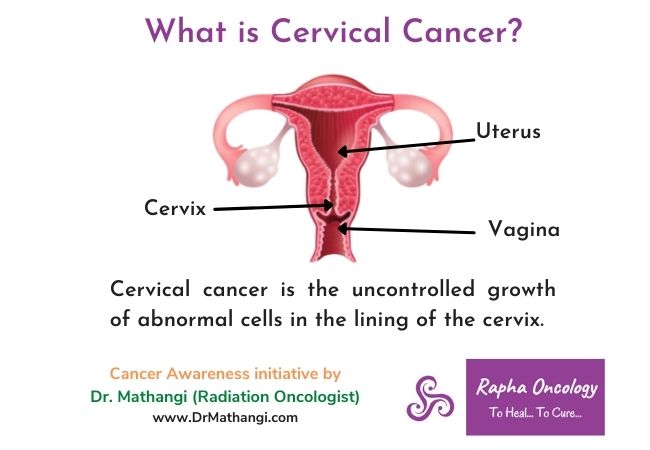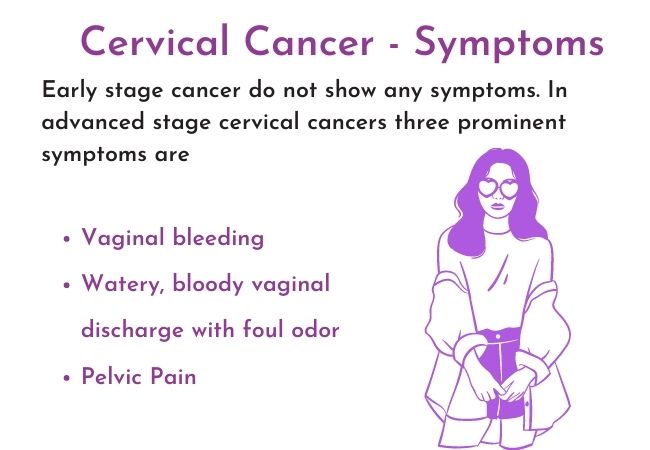
The other risk factors are

STAGE 0: This stage is called as carcinoma in situ, means some abnormal cells are present in the innermost lining of the cervix
STAGE 1: Invasive cancer that is strictly restricted to the cervix
STAGE 2: Cancer has spread beyond the uterus but not the pelvic sidewall or the lower third of the vagina
STAGE 3:Cancer has spread from the cervix into nearby structures or into the lymph nodes in the pelvis or abdomen
STAGE 4: Cancer has spread to the bladder or rectum or further away

1. USG / Sonography of the Pelvis: It gives a basic idea of the source of bleeding as uterine vs cervical origin but does not give the complete information needed for staging or treatment purposes
2. MRI scan of the pelvis with IV contrast: is the ideal investigation in the evaluation of cervical cancer
- It gives important information about the extent of the local growth, involvement of the adjacent organs and the lymph nodes. Hence it helps in deciding if the cancer can be managed with surgery or to be treated with radiotherapy directly without surgery
3. CT scan abdomen and pelvis with IV contrast or Whole body PET CT scan: mainly done in advanced cases to check for the cancer spread to the abdomen or other structures like lungs and liver. This also gives an idea about the functioning or patency of the urinary tract in very advanced cancers
· All imaging should be preferably done before doing the biopsy or any invasive procedures
4. Biopsy: It is regular OPD procedure where a small amount of the tumor material is collected and checked for the presence of cancer. In very early stages, Colposcopy guidance will be needed to direct the site of biopsy. Some special stains like acetic acid etc. might also help in the highlighting the lesion in very early stages like in screening population
Standard treatment methods for cervical cancer are:
· Surgery: It plays an important role in management of the early stage cancers, when ONLY limited to cervix. Depending on the stage (stage 0/ stage I), the surgery can vary from simple removal of uterus alone or uterus with the adjacent supporting ligaments (parametrium) along and the removal of the lymph nodes in the pelvic region. Generally surgery is NOT a preferred modality for stage 2 and above cancers.
· Chemotherapy: It is generally given once a week along with radiotherapy in early and locally advanced cancers to improve the effects of radiation. In occasional cases with paraaortic nodes, radical doses of two drugs are given to improve the local control and survival rates.
· Radiation therapy: This is the most important modality of treatment of cervical cancers as majority of cases in India present with locally advanced cancers.
- Radical or curative radiotherapy: For cancers with stages 2 and above, radiotherapy is given to cure the cancers along with weekly small doses of chemotherapy to enhance its effects
- Post operative / adjuvant radiotherapy: It is also advised after surgery if the post operative histopathology report suggests high chances of tumour coming back (recurrence)
- Palliative radiotherapy: Radiotherapy is given in advanced stages only to control the symptoms / complaints like severe bleeding or pain due to the tumour.
Most often, two types of radiotherapy will be used:
o External beam radiation
o Brachytherapy / internal radiotherapy
· External beam radiation therapy (EBRT) uses high energy X-rays (with) to destroy cancer cells from a machine called Linear Accelerator from outside the body. The treatment is painless and lasts only 5-10 minutes per session (per day). It is generally given 5 days in a
week on OPD basis. The entire duration of treatment lasts over 5-6 weeks depending on the involvement or enlargement of the lymph nodes. It is directed to the tumour site along with the possible areas of the microscopic spread like the adjacent ligaments (parametrium) and the pelvic and abdominal lymph nodes.
· Brachytherapy, also known as internal radiotherapy where high-dose radiation is given to the cancer cells from within (in the uterine cavity or inside the tumour), thereby reducing the radiation spill to the surrounding tissues. It forms an integral part of management of cervical cancers given after external radiotherapy.
The metallic applicators are placed in the uterine cavity (Intra cavitary) or directly within the cancer (Interstitial brachytherapy) under sedation or anaesthesia. Computer based planning is done with CT / MRI image guidance to direct the place and duration of treatment with the small radioactive source. Once the planning is done, the applicators are connected to the machine containing the radioactive source.
In the modern day set up the brachytherapy is completely computer based, remotely controlled from the console and of very short duration (15 – 20 minutes). After the treatment is over, the applicators are removed.
